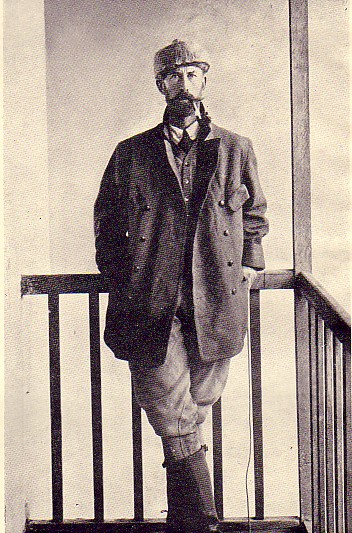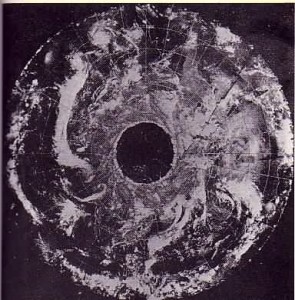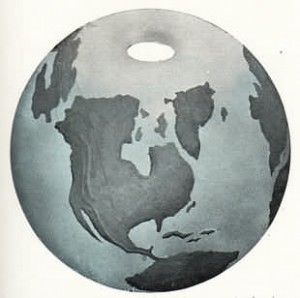Sacred Connections Scotland
The Hollow Earth Enigma
Barry Dunford
During the early twentieth century, a Russian explorer, Ferdinand Ossendowski, travelled extensively in Mongolia, central Asia. Some of his travels and experiences are recorded in his book Beasts, Men and Gods, first published in English in 1922. In this work Ossendowski tells of a remarkable story which was imparted to him concerning a subterranean kingdom which constitutes an inner earth domain. This kingdom was known to the Asian Buddhist Lamas as Agharti. Interestingly, Ossendowski was informed that the entrance to this subterranean world was a cave which was marked with the inscription “This is the gate to Agharti”. Another Russian explorer, Nicholas Roerich, comments on this curious matter in his book, Abode of Light (1947): “Among the innumerable legends and fairytales of various countries may be found the tales of lost tribes or subterranean dwellers. In wide and diverse directions, people are speaking of identical facts. But in correlating them you can readily see that these are but chapters from the one story. At first it seems impossible that there should exist any connection between these distorted whispers, but afterwards you begin to grasp a peculiar coincidence in these manifold legends by people who are even ignorant of each other’s names. You recognize the same relationship in the folklore of Tibet, Mongolia, China, Turkestan, Kashmir, Persia, Altai, Siberia, the Urals, Caucasia, the Russian steppes, Lithuania, Poland, Hungary, France, Germany..”
In his fascinating and informative book The Lost World of Agharti (1982) the author, Alec MacLennan, covers in considerable detail the worldwide ramifications of this subterranean kingdom. He shows that there may well be a number of cavernous openings on various parts of the globe which in effect are portals into an inner earth domain. He locates one such entrance in the remote West Riding of Yorkshire, England, and others have been reported, in particular, throughout various parts of the Americas. To quote Alec MacLennan: “Taking the legend in its most basic form, Agharti is said to be a mysterious underground kingdom situated somewhere beneath Asia and linked to the other continents of the world by a gigantic network of tunnels. These passageways, partly natural formations and partly the handiwork of the race which created the subterranean nation, provide a means of communication between all the points, and have done so since time immemorial. According to the legend, vast lengths of the tunnels still exist today; the rest have been destroyed by cataclysms. The exact location of these passages, and the means of entry, are said to be known only to certain high initiates, and the details are most carefully guarded because the kingdom itself is a vast storehouse of secret knowledge. These manuscripts are claimed to be the works of the lost Atlantean civilization and of an even earlier people who were the first intelligent beings to inhabit the earth.”
Furthermore, in an autobiographical volume entitled My Joyful Life, Charles James Cutcliffe-Hyne (1865-1944) who lived in the West Riding of Yorkshire, England, provides the following interesting information: “In South America I heard tell that there were enormous tunnels that traverse the continent, ultimately linking with this forbidden place. More curious still, there was similar talk in Europe, and even some old people in the West Riding knew the story and believe there to be entrances through their own caves. The kingdom was said to be called Agharti.” Moreover, in The Subterranean World (1960), the author Dr. Raymond Bernard states: “Throughout the Buddhist world of the Far East, belief in the existence of a Subterranean World, which is given the name Agharti, is universal and is an integral part of the Buddhist faith.. Buddhist traditions state that Agharti was first colonised many thousands of years ago when a holy man led a tribe which disappeared underground. This reminds one of Noah, who was really an Atlantean, who saved a worthy group prior to the coming of the flood that submerged Atlantis.”
Another curious enigma, which may have some bearing on the foregoing, concerns the mysterious disappearance of the English explorer Col. Percy H. Fawcett in the Matto Grosso Amazonian region of central Brazil, in 1925. Fawcett disappeared without any subsequent trace with two companions, his elder son Jack and an American friend, Raleigh Rimell. The intrepid explorer was searching for an ancient Lost City which he believed might have links with the antedeluvian civilisation known as Atlantis. Before setting off on his last fateful journey, Col. Fawcett communicated to his younger son Brian: “The answer to the enigma of Ancient South America – and perhaps of the prehistoric world – may be found when those old cities are located and opened up to scientific research. That the cities exist, I know..”

Lt. Col. P. H. Fawcett, D.S.O., F.R.G.S.
When writing about Col. Fawcett’s mysterious disappearance in Brazil, Dr. Raymond Bernard states in his book The Hollow Earth (1979): “These mysterious tunnels, an enigma to archaelogists, exist in greatest number under Brazil, where they open on the surface in various places. The most famous is in the Roncador Mountains of northeast Matto Grosso to where Colonel Fawcett was heading when last seen. It is claimed that the Atlantean city for which he searched was not the ruins of a dead city on the surface but a subterranean city with still living Atlanteans as its inhabitants; and that he and his son Jack reached this city and are still living therein.” Invariably, the cave/tunnel opening portals to the inner earth domain appear to be located within mountainous regions such as the vast Roncador range towards which Col. Fawcett was heading when he and his two companions disappeared without trace. Indeed, Fawcett remarked: “The mountains there are quite high. We shall then follow the mountains..”
While commenting on the Andes and Himalayan mountain ranges, Kenneth Rayner Johnson, in his book The Fulcanelli Phenomenon (1980) says: “In both these regions, the one below and the other above the equator, there are numerous legends of secret treasuries and libraries deep within the mountains. Of refuges in which mankind sheltered from a world disaster.” He also refers to: “Katmandhu, and the persistent legends of concealed entrances into the bowels of the mountains that are associated with that place.”

Satellite photograph (1968)
The concept of the Earth being hollow is one which has been written about for at least the past century or so. In 1920, Marshall B. Gardner produced a revised edition of an earlier work published in 1913 entitled A Journey to the Earth’s Interior. In his second edition the author produces a diagrammatic plate showing the earth as a hollow planet with an opening entrance at the North Pole. What is significant is that a photograph taken by the ESSA -7 satellite on 23rd November 1968 over the North Pole, without cloud cover, clearly reveals a substantial circular opening which, it is claimed, was navigated by Rear Admiral Richard E. Byrd (United States Navy) on a secret expedition made in 1947. Over a period of time much material has been written about the hollow earth theory, and recently a book has been published (Hollow Planets: A Feasibility Study of Possible Hollow Worlds by Jan Lamprecht, 1998) which suggests that all the planets in the Universe may be hollow, a creative principle which may hold true throughout the stellar worlds.

Marshall B. Gardner (1920)
In more recent times the theory of a hollow earth is generally believed to have been first investigated by an American writer, William Reed, in 1906 and subsequently by another American, Marshall B. Gardner, as previously mentioned. However, what is not so well known, is that in 1898 a 48 page booklet was produced entitled The Secret of the Poles. The author was a certain Henry Campion and his treatise was published in Birmingham, England. In advance of the aforementioned two American hollow earth researchers, Campion wrote that the earth was hollow with entrances at both the north and south poles. To quote Campion: “The earth’s axis is completely hollow, and entirely devoid throughout – from south to north – of terra firma; it has two complete openings, one at the South Pole, the other at its exact opposite, the North Pole, it is continuously hollow, and completely open throughout its supposed dense structure from pole to pole, quite literally and completely.”

Illustration from The Secret of the Poles
To again quote Dr. Raymond Bernard from his book The Hollow Earth (1979): “The theories of Reed and Gardner found confirmation in the Arctic and Antarctic expeditions of Rear Admiral Richard E. Byrd in 1947 and 1956 respectively, which penetrated for 1,700 miles beyond the North Pole and 2,300 miles beyond the South Pole, into a new unknown, iceless territory not recorded on a map, extending inside the polar depressions and openings that lead to the hollow interior of the earth.. Admiral Byrd’s discovery is today a leading international top secret, and it has been so since it was first made in 1947. After Byrd made his radio announcement from his plane and after a brief press notice, all subsequent news on the subject was carefully suppressed by government agencies. There was an important reason for this. Before he left on his seven hour flight from his arctic base over iceless lands beyond the North Pole (leading to the interior of the Earth), Admiral Byrd said: ‘I would like to see that land beyond the Pole. That area beyond the Pole is the center of the Great Unknown’.” In November 1955, before embarking on his South Polar expedition, Admiral Byrd stated: “This is the most important expedition in the history of the world.” Further, a radio announcement from Byrd’s Antarctic expedition, confirmed by the American Press of February 5th 1956, stated: “On January 13th, members of the United States expedition accomplished a flight of 2,700 miles from the base at McMurdo Sound, which is 400 miles west of the South Pole, and penetrated a land extent of 2,300 miles beyond the Pole.” On his return from this South Polar expedition Admiral Byrd, on March 13th 1956, remarked that: “The present expedition has opened up a vast new territory.” Rear Admiral Byrd died the following year at sixty eight years of age.
In support of the hollow earth theory an intriguing tale is recorded in a book entitled Belden, the White Chief; or, Twelve Years among the Wild Indians of the Plains, which was published in 1870 in the USA. The book is a compilation, edited by General James S. Brisbin, from the diaries and manuscripts of George P. Belden, who is described as “The Adventurous White Chief, Soldier, Hunter, Trapper, and Guide”. On page 52 is recorded part of Belden’s conversation with a North American Plains Indian squaw named Washtella. The pertinent extract reads as follows: “Washtella, tell me where your people first came from.” “Long, long ago” she said, “They lived in the earth, which is hollow; but one day they came to an opening and came out, when, liking the outside best, they stayed and would not return. My own father once saw the hole they came out of, but I never saw it, as it is far down the Missouri, where the white man lives.” (my italics – BD). The North American Indian inner earth notion is further supported in Archaic England , 1919, by Harold Bayley who says: “.. the Mandan Indians of North America have a curious legend suggestive of the idea that they must have sprung from some troglodite race. The whole Mandan nation, it is said, once resided in one large village underground near a subterranean lake.. There is seemingly some like relation between this legend and the tradition held by certain hill tribes of the old Konkan kingdom in India, who have a belief that their ancestors came out of a cave in the earth.”
The following intriguing information was provided by L. Christine Hayes in the first issue of The Source, a journal which she began in 1980. She says: “There are four massive natural openings into the Central Earth. These are known to the Sky-Earth Tribes as the Northern, Southern, Eastern, and Western Doors. The Northern and Southern Doors are the natural openings at the poles of the planet. These opulent shaped space areas ARE the magnetic polar vortexes of Earth. Because of the type of magnetic pulse in these regions, it is difficult for a traveller to wander into the openings. The magnetic field interacts within the individual’s brain pulse, impressing an illusion upon the magnetic and physical systems that a straight course exists where actually there is a curve in space. Despite this natural protective field, there are surface dwellers who have wandered into the polar opulents. For those who know the mechanics of spectral-polar magnetism, as do the inhabitants of the Interior World, travelling through the magnetic veils is a simple process. The Eastern and Western Doors are located in the Himalayas and beneath the Titicacan Plateau of the Andes in Brazil, respectively. While these were originally large, naturally hollowed passages, they have been maintained and enhanced through the centuries. There is a fifth natural passage, known as the ‘Sacred Knot’ or ‘The Navel’, where the merging energies from the Four Doors passes through. The tunnel is located in the Four Corners region of the South-western United States.. There are other natural, smaller, closed passages which are artificially maintained and large enough for human passage. Some of the more prominent of these are: Mt. Shasta in Northern California, Mt. Teton in Wyoming, Mt. Hood in Washington State, Mt. Robson in British Columbia, and the still active volcano of Mauna Loa on the Island of Hawaii.”
If the notion of a hollow earth is viewed as somewhat tenuous, then how can all of the foregoing information be accounted for?